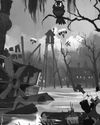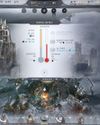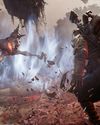
As a professor who studies the politics of games, I’m fascinated by the late 1990s. This period of massive technological innovation was also the crucible in which modern gaming culture was forged. When researching the era I sometimes encounter such an odd piece of gaming ephemera that I can’t resist tracking it down—like Lara Croft: The Art of Virtual Seduction, a book published by Prima Games in 2000. “Everyone knows how to make this tomb raider jump, shimmy and swim,” the ad suggested, “but do you know what makes her tick?” I did not know what made Lara tick, so I rushed to eBay to purchase a tattered copy. What arrived at my doorstep is a fascinating window into gaming at the turn of the millennium.
It’s difficult to overstate the impact Tomb Raider had in 1996. Riding the wave of early 3D gaming, Tomb Raider helped redefine the action-adventure platformer and spawned numerous copycats. Tomb Raider had something going for it that its imitators couldn’t match: Lara Croft.
VIRTUAL SEX SYMBOL
Today asking “who is Lara Croft?” would sound almost as absurd as asking “who is Mario?” Lara remains one of the most iconic characters in gaming history. But when Lara debuted, female protagonists were still quite rare – especially female action heroes. As a quippy gun-toting lead, Lara Croft occupied a space typically reserved for the Duke Nukems of the world. While the team at Core Design initially envisioned a male protagonist, the decision to change their hero into a heroine ended up dramatically shaping how Eidos would market the series.
This story is from the {{IssueName}} edition of {{MagazineName}}.
Start your 7-day Magzter GOLD free trial to access thousands of curated premium stories, and 9,000+ magazines and newspapers.
Already a subscriber ? Sign In
This story is from the {{IssueName}} edition of {{MagazineName}}.
Start your 7-day Magzter GOLD free trial to access thousands of curated premium stories, and 9,000+ magazines and newspapers.
Already a subscriber? Sign In

"The War Within itself has kept me coming back most evenings too"
WORLD OF WARCRAFT remains my jailer, and I couldn't be more pleased about it

OK BUILDER
SATISFACTORY is the new titan in building and crafting games

HELL YES
DIABLO IV: VESSEL OF HATRED is a transformative expansion

MOUSE: PI FOR HIRE
This mouse wants to be more than just a gimmick

WINDBLOWN
Dead Cells dev's new roguelike has me afraid for my free time

NO MORE ROOM IN HELL 2
As the zombie horde surrounded me just moments after taking down my two remaining teammates, the writing was really on the wall. Armed with just a chef's knife, it was clear I stood no chance, but I was going down swinging, hoping for a miracle... it didn't come.

OWNED BY STEAM
VALVE cordially reminds you that your games aren't yours

CURSE OF THE AZURE BONDS
These classic games haven't aged badly, but I sure have.

DEEP FREEZE
Endure a blizzard of tough choices and rough consequences in FROSTPUNK 2

NEW HORIZONS
Building up REMNANT 2 outside the live service game grinder